Cathryn Shilling | Fabulous Fusion by Catherine Rose for Mosaic & Glass Magazine
14th July 2023
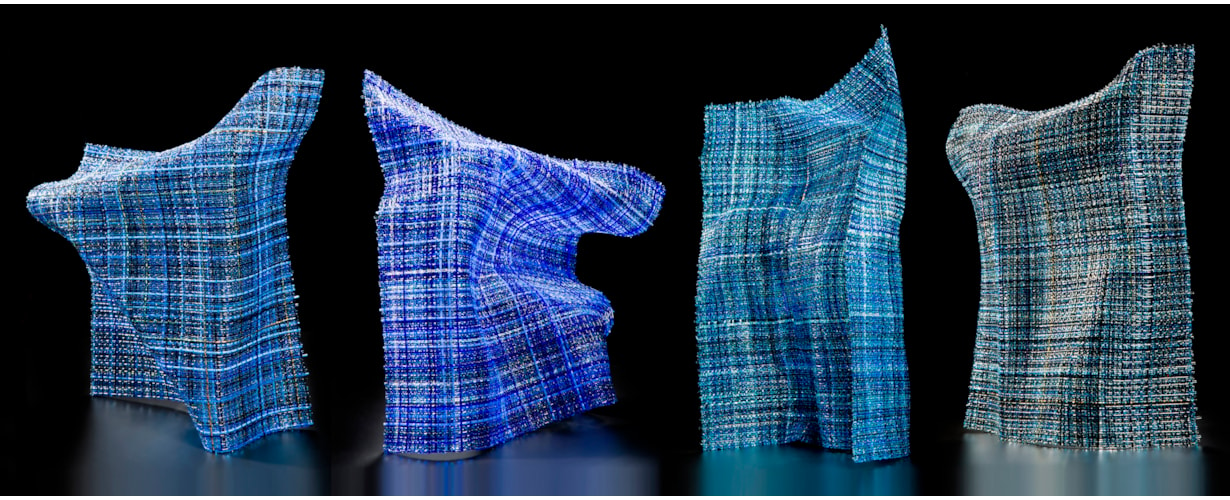
Cathryn Shilling | Fabulous Fusion by Catherine Rose for Mosaic & Glass - The Magazine for Mosaicists | March 2023
Fused glass is the heat bonding of separate pieces of glass in a kiln – a technique believed to be over 4,000 years old. More accessible than hot glass, there are hundreds of ways an artist can create diverse pieces using this method. Small wonder that it has become so popular. Catherine Rose meets the artist and expert, Cathryn Shilling.
Glass artist Cathryn Shilling describes kiln-formed glass as “the perfect medium”. However, with a background in hot glass, her ideal is to combine both.
After a spinal tumour in 2021 put an end to her glass blowing, Cathryn continued designing and kiln forming in her studio while working directly with hot shop artists such as Louis Thompson, James Devereux and Katherine Huskie (of Devereux Huskie Studio) to fully realise her visions. It is a marriage that succeeds for her.
One of Cathryn’s trademarks is that she can make glass resemble flowing fabric, something she was inspired to try while a student. “Early on in my fused glass course, I saw an exhibition at the V&A by Sue Lawty, then a textile artist in residence. She had done a little case of test pieces using sticks and strips of lead. It was absolutely beautiful work and I wondered if you could weave glass. I went back to the studio to experiment.”
Using fused glass canes, Cathryn produced "woven" glass in tartan designs, sewing small 10cm squares together with wire to make a “glass quilt”. She then made a light shade using hundreds of squares, titled 'Glassworks Quilt'. Since then, Cathryn has moved on to producing standing forms, which have become increasingly figurative. She mainly uses Bullseye stringers for her work, some of which are only 1mm thick.
![]()
Glassworks Quilt
Unique | H 37 cm W 37 cm D 107 cm | Photo by Ester Segarra
Cathryn uses “a painstaking process” to bring each strand together. She then fuses them in the kiln until they resemble sheets of woven fabric. The sheets are subsequently re-fired and shaped by slumping, moulding, bending or draping the glass to become three-dimensional artworks, ranging from free-standing sculptures to bowls.
There is a strong sense of movement in all of Cathryn’s pieces. A recent body of work, 'Cloaked', comprises free-blown glass figures that are draped with kiln-formed glass fabric applied hot. “Clothing conveys so many things,” says Cathryn. “Not only does it protect against the elements, but it also broadcasts your identity within society, as well as refecting your mood and emotional situation. My pieces explore these themes and the associated misconceptions and judgments that we’re all guilty of making.”
For Cloaked, Cathryn used the traditional Venetian roll-up technique innovatively, inverting the process so that it occurs at the final stage (a method devised by Australian glass artist Scott Chaseling). The pre-heated glass fabric is picked up onto a finished blown glass form and put into the glory hole. Heat and gravity shape the "cloth" serendipitously, enrobing the figure with fluidity and spontaneity.
![]()
Cloaked Collection
Each unique | H 60 cm - 68 cm | Photo credit Ester Segarra
“I enjoy the interplay between kiln-formed glass and blown glass and the roll-up technique allows me to explore this,” explains Cathryn. “The vessels are made from pre-fused glass sheets that are picked up hot, rolled and hand blown. This technique allows me to create three-dimensional objects with a greater level of control and design than can usually be achieved in a hot shop.”
For her 'Synergy Series', Cathryn wanted sculptures that were “a suggestion of fabric being blown gently against a figurative form", using colour and light to give a sense of movement. Three pieces from 'Synergy Series I' will be exhibited in Sur le Fils at MusVerre, Sars Poterie, France from 11 February to 20 August 2023; while 'Synergy Series III' will be exhibited in the Tartan Exhibition at the new V&A Dundee from 1 April 2023 to 14 January 2024.
![]()
Synergy Series
Each unique | H 44 cm - 47 cm | Photo by Ester Segarra
Cathryn is drawn to the idea of kinesis and body language, something she has explored further in her separate series of works Metamorphosis (which uses gold), Dissonance, and Hidden Gestures – a solo show at Vessel Gallery, London in 2019 to commemorate her ten years of professional practice. “I approach each project as a graphic designer, deciding on the best techniques for each,” says Cathryn. For one of her artworks, 'The Path We Follow', Cathryn found mosaic was the best way of interpreting her idea.
An environmental comment, the artwork illustrates global warming across Europe using observed data. The installation is in two parts: a mosaic visualises the temperature change across Europe from 1975-2020, while blown vessels represent an assembly of European nations, each displaying a rise in temperature over 80 years. The work's message is that, by acting now, we can follow a new temperature path to a sustainable future.
At this year's glass art Society conference in Tacoma, Cathryn did a demonstration alongside glassblower and artist Louis Thompson entitled 'Shrouded in Myth - An Innovative Approach to Combining kiln-Formed and Blown Glass'. For this, she conceived Only Hope Remains, which corrects a mistranslation in the Ancient Greek myth. Pandora originally came to Earth with a pithos ("jar" in Ancient greek). This was subsequently miswritten as pyxis ("box") in a translation by Erasmus in the 1600s, hence the Pandora's Box we are all familiar with. When Pandora released evil into the world, hope was caught in the lip of the jar. Cathryn recreated the concept of Pandora's jar in glass but inverted the story so that the jar releases hope and retains evil. Hope is something that resonates with her as a disabled artist.
![]()
Only Hope Remains I & Only Hope Remains II
Both unique | H 59 cm - 60 cm | Photo by Agata Pec
“Disabled people are often overlooked in the world of glass" she says. “But I have found a way of being actively involved in one of the most physically demanding crafts there is. Being disabled doesn't have to limit your ideas or your practice."
Asked what she thinks is the best aspect of working with fused glass she says, “Working with [kiln-formed} glass is very meditative. It's what I love most about it."
About the Artist
Cathryn Shilling is a glass artist living and working in London. After graduating in graphic design from the Central School of Art and Design in London, Cathryn worked as a designer until a move to the USA in 2001 prompted her to pursue a new direction. She studied the Art and Craft of Stained Glass in Connecticut and then on her return to London in 2004 was introduced to kiln-formed glass at Kensington and Chelsea College, as well as becoming a student of blown glass at Peter Layton's London Glassblowing Studio. In 2009, she began her professional practice in a studio near her home in London. She was London Glassblowing Gallery's curator from 2010 - 2019 and is a member of the Art Workers Guild and a fellow of the Society of Designer Craftsmen. Cathryn's work has been widely exhibited internationally and she has won numerous awards. She has also been shortlisted as one of 'the most game-changing female glass artists' by Glassation.
CATHRYN SHILLING’S TOP TIP FOR ARTISTS “Test, test, test. Learn your kiln and try ideas out at different temperatures. Don’t be afraid to do something different.”
![]()
Artist portrait by Anthony Scala.
Further artworks by Cathryn Shilling
Hidden Gestures a solo exhibition by Cathryn Shilling
With thanks to Mosaic & Glass magazine
Photography Ester Segarra & Agata Pec
Fused glass is the heat bonding of separate pieces of glass in a kiln – a technique believed to be over 4,000 years old. More accessible than hot glass, there are hundreds of ways an artist can create diverse pieces using this method. Small wonder that it has become so popular. Catherine Rose meets the artist and expert, Cathryn Shilling.
Glass artist Cathryn Shilling describes kiln-formed glass as “the perfect medium”. However, with a background in hot glass, her ideal is to combine both.
After a spinal tumour in 2021 put an end to her glass blowing, Cathryn continued designing and kiln forming in her studio while working directly with hot shop artists such as Louis Thompson, James Devereux and Katherine Huskie (of Devereux Huskie Studio) to fully realise her visions. It is a marriage that succeeds for her.
One of Cathryn’s trademarks is that she can make glass resemble flowing fabric, something she was inspired to try while a student. “Early on in my fused glass course, I saw an exhibition at the V&A by Sue Lawty, then a textile artist in residence. She had done a little case of test pieces using sticks and strips of lead. It was absolutely beautiful work and I wondered if you could weave glass. I went back to the studio to experiment.”
Using fused glass canes, Cathryn produced "woven" glass in tartan designs, sewing small 10cm squares together with wire to make a “glass quilt”. She then made a light shade using hundreds of squares, titled 'Glassworks Quilt'. Since then, Cathryn has moved on to producing standing forms, which have become increasingly figurative. She mainly uses Bullseye stringers for her work, some of which are only 1mm thick.
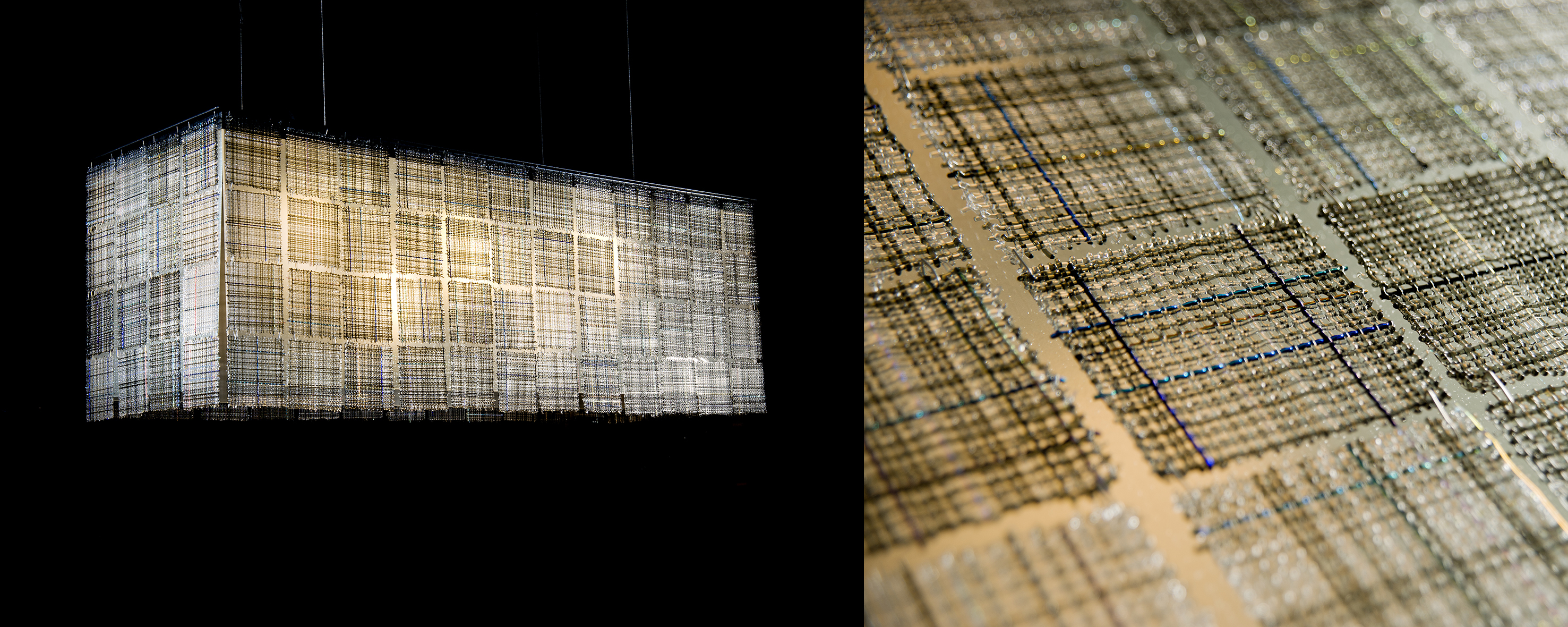
Glassworks Quilt
Unique | H 37 cm W 37 cm D 107 cm | Photo by Ester Segarra
Cathryn uses “a painstaking process” to bring each strand together. She then fuses them in the kiln until they resemble sheets of woven fabric. The sheets are subsequently re-fired and shaped by slumping, moulding, bending or draping the glass to become three-dimensional artworks, ranging from free-standing sculptures to bowls.
There is a strong sense of movement in all of Cathryn’s pieces. A recent body of work, 'Cloaked', comprises free-blown glass figures that are draped with kiln-formed glass fabric applied hot. “Clothing conveys so many things,” says Cathryn. “Not only does it protect against the elements, but it also broadcasts your identity within society, as well as refecting your mood and emotional situation. My pieces explore these themes and the associated misconceptions and judgments that we’re all guilty of making.”
For Cloaked, Cathryn used the traditional Venetian roll-up technique innovatively, inverting the process so that it occurs at the final stage (a method devised by Australian glass artist Scott Chaseling). The pre-heated glass fabric is picked up onto a finished blown glass form and put into the glory hole. Heat and gravity shape the "cloth" serendipitously, enrobing the figure with fluidity and spontaneity.
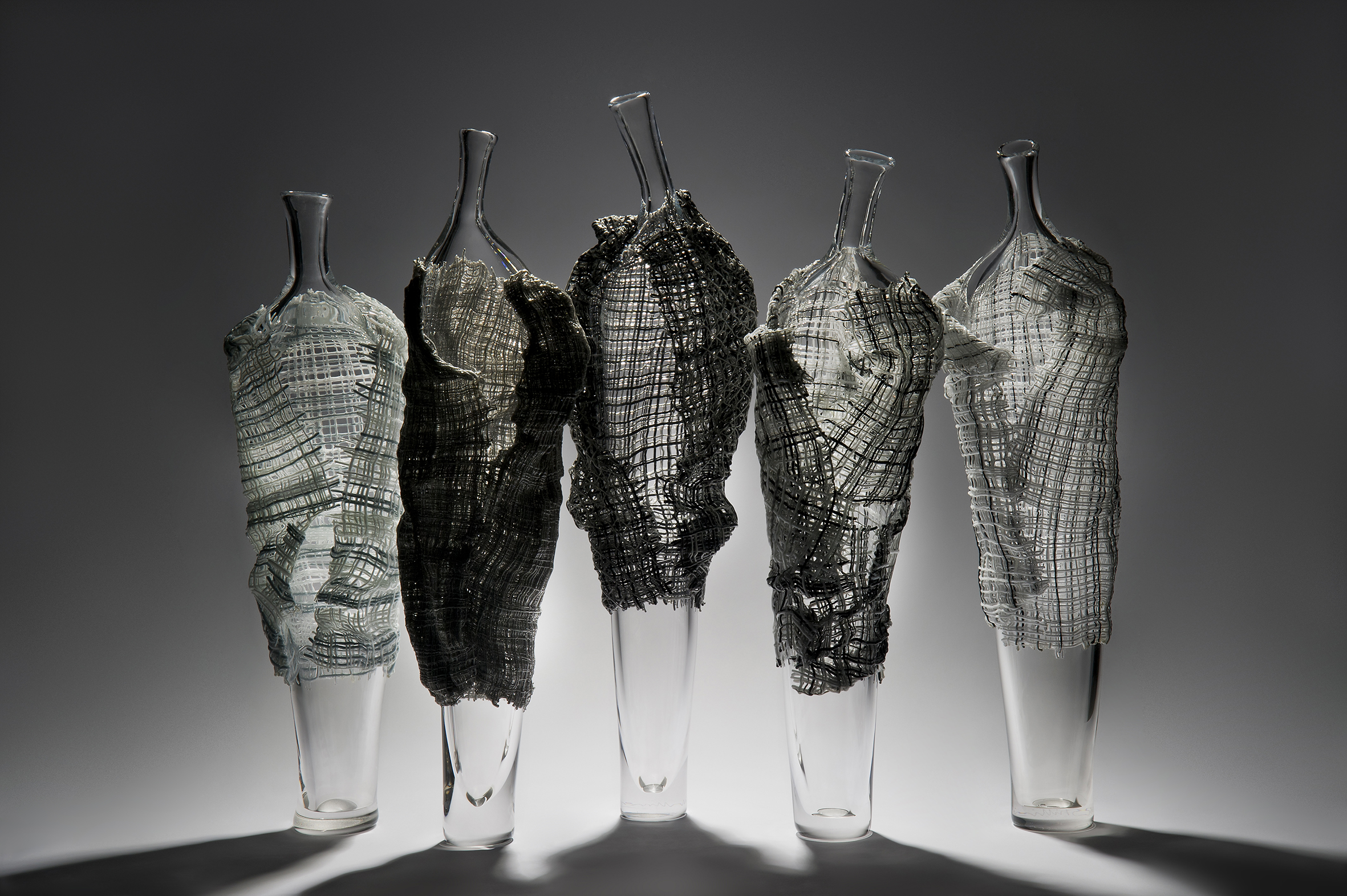
Cloaked Collection
Each unique | H 60 cm - 68 cm | Photo credit Ester Segarra
“I enjoy the interplay between kiln-formed glass and blown glass and the roll-up technique allows me to explore this,” explains Cathryn. “The vessels are made from pre-fused glass sheets that are picked up hot, rolled and hand blown. This technique allows me to create three-dimensional objects with a greater level of control and design than can usually be achieved in a hot shop.”
For her 'Synergy Series', Cathryn wanted sculptures that were “a suggestion of fabric being blown gently against a figurative form", using colour and light to give a sense of movement. Three pieces from 'Synergy Series I' will be exhibited in Sur le Fils at MusVerre, Sars Poterie, France from 11 February to 20 August 2023; while 'Synergy Series III' will be exhibited in the Tartan Exhibition at the new V&A Dundee from 1 April 2023 to 14 January 2024.

Synergy Series
Each unique | H 44 cm - 47 cm | Photo by Ester Segarra
Cathryn is drawn to the idea of kinesis and body language, something she has explored further in her separate series of works Metamorphosis (which uses gold), Dissonance, and Hidden Gestures – a solo show at Vessel Gallery, London in 2019 to commemorate her ten years of professional practice. “I approach each project as a graphic designer, deciding on the best techniques for each,” says Cathryn. For one of her artworks, 'The Path We Follow', Cathryn found mosaic was the best way of interpreting her idea.
An environmental comment, the artwork illustrates global warming across Europe using observed data. The installation is in two parts: a mosaic visualises the temperature change across Europe from 1975-2020, while blown vessels represent an assembly of European nations, each displaying a rise in temperature over 80 years. The work's message is that, by acting now, we can follow a new temperature path to a sustainable future.
At this year's glass art Society conference in Tacoma, Cathryn did a demonstration alongside glassblower and artist Louis Thompson entitled 'Shrouded in Myth - An Innovative Approach to Combining kiln-Formed and Blown Glass'. For this, she conceived Only Hope Remains, which corrects a mistranslation in the Ancient Greek myth. Pandora originally came to Earth with a pithos ("jar" in Ancient greek). This was subsequently miswritten as pyxis ("box") in a translation by Erasmus in the 1600s, hence the Pandora's Box we are all familiar with. When Pandora released evil into the world, hope was caught in the lip of the jar. Cathryn recreated the concept of Pandora's jar in glass but inverted the story so that the jar releases hope and retains evil. Hope is something that resonates with her as a disabled artist.
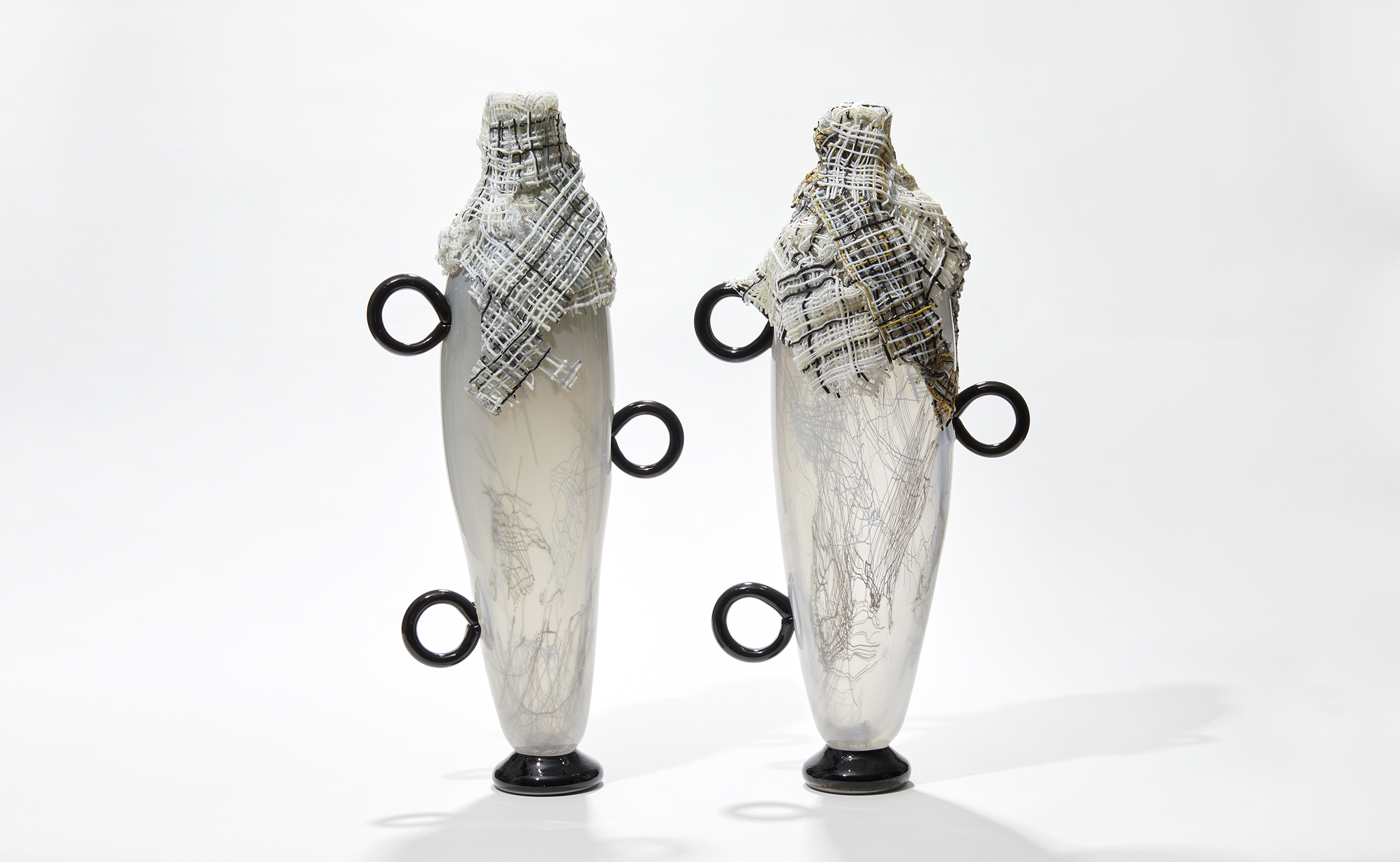
Only Hope Remains I & Only Hope Remains II
Both unique | H 59 cm - 60 cm | Photo by Agata Pec
“Disabled people are often overlooked in the world of glass" she says. “But I have found a way of being actively involved in one of the most physically demanding crafts there is. Being disabled doesn't have to limit your ideas or your practice."
Asked what she thinks is the best aspect of working with fused glass she says, “Working with [kiln-formed} glass is very meditative. It's what I love most about it."
About the Artist
Cathryn Shilling is a glass artist living and working in London. After graduating in graphic design from the Central School of Art and Design in London, Cathryn worked as a designer until a move to the USA in 2001 prompted her to pursue a new direction. She studied the Art and Craft of Stained Glass in Connecticut and then on her return to London in 2004 was introduced to kiln-formed glass at Kensington and Chelsea College, as well as becoming a student of blown glass at Peter Layton's London Glassblowing Studio. In 2009, she began her professional practice in a studio near her home in London. She was London Glassblowing Gallery's curator from 2010 - 2019 and is a member of the Art Workers Guild and a fellow of the Society of Designer Craftsmen. Cathryn's work has been widely exhibited internationally and she has won numerous awards. She has also been shortlisted as one of 'the most game-changing female glass artists' by Glassation.
CATHRYN SHILLING’S TOP TIP FOR ARTISTS “Test, test, test. Learn your kiln and try ideas out at different temperatures. Don’t be afraid to do something different.”
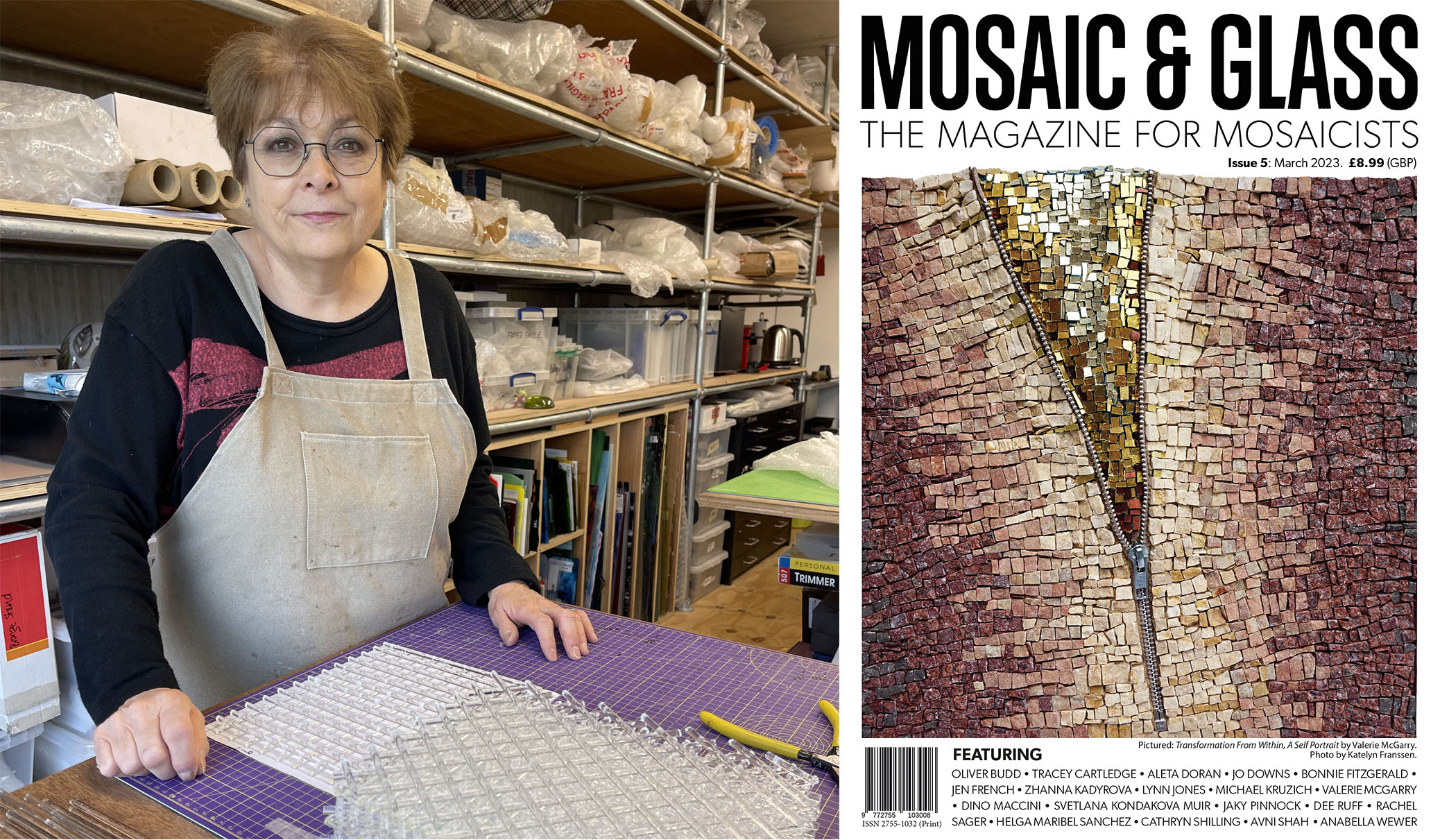
Artist portrait by Anthony Scala.
Further artworks by Cathryn Shilling
Hidden Gestures a solo exhibition by Cathryn Shilling
With thanks to Mosaic & Glass magazine
Photography Ester Segarra & Agata Pec

